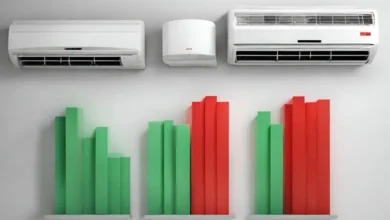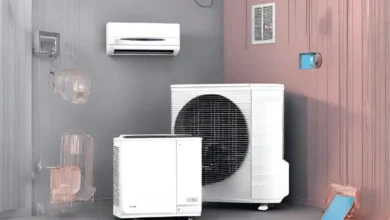Environmental Considerations in Proper Air Conditioning

In the delicate balance between comfort and environmental responsibility, air conditioning (AC) has become a staple, offering solace from scorching temperatures and creating pleasant indoor environments. However, as we revel in the refreshing coolness, it’s crucial to cast a mindful eye toward the environmental impact of our AC choices. This comprehensive exploration aims to unveil the intricate relationship between proper air conditioning practices, sustainable considerations, technological innovations, and the collective responsibility to foster a greener, cooler future.
Also read: Best AC in India 2024
1. The Ecological Footprint of Traditional Air Conditioning Systems
1.1. Refrigerants and Their Role in Climate Change
Traditional AC systems often rely on refrigerants that, while effective in cooling, can have a significant impact on the environment. Many commonly used refrigerants are potent greenhouse gases, contributing to ozone depletion and climate change. Understanding the environmental implications of refrigerants becomes paramount for making informed choices.
1.2. Energy Consumption and Carbon Emissions
Moreover, the energy demand of AC systems is a major contributor to carbon emissions. In regions where electricity is generated from fossil fuels, the carbon footprint of air conditioning becomes pronounced. Energy-efficient systems and responsible energy management practices emerge as crucial components in mitigating this environmental impact.
2. Rethinking Air Conditioning Practices for Sustainability
2.1. Energy-Efficient Cooling Technologies
Embracing energy-efficient cooling technologies represents a significant stride towards sustainability. Modern AC units, equipped with advanced technologies such as variable-speed compressors and inverter technology, not only optimize energy usage but also contribute to substantial energy savings. This aligns seamlessly with environmental conservation goals.
2.2. The Rise of Eco-Friendly Refrigerants
In response to the environmental challenges posed by traditional refrigerants, the industry is witnessing a shift towards eco-friendly alternatives. Hydrofluorocarbon (HFC)-free refrigerants, such as hydrofluoroolefins (HFOs), are gaining prominence due to their lower global warming potential. This marks a positive step in minimizing the environmental impact of air conditioning systems.
3. Smart Technologies for Sustainable Cooling
3.1. Smart Thermostats and Precision Cooling
The integration of smart technologies introduces precision and efficiency into air conditioning practices. Smart thermostats, equipped with sensors and connectivity features, enable precise temperature control and adaptive cooling based on occupancy. This not only enhances comfort but also minimizes unnecessary energy consumption, contributing to a more sustainable cooling experience.
3.2. Remote Monitoring and Energy Management
Moreover, remote monitoring capabilities empower users to track and manage their AC systems in real-time. By remotely adjusting settings, identifying inefficiencies, and optimizing usage patterns, individuals and organizations can play an active role in reducing energy consumption and fostering environmental responsibility.
4. Harnessing Renewable Energy for Cooling Needs
4.1. Solar-Powered Air Conditioning Systems
The synergy between air conditioning and renewable energy sources, particularly solar power, presents a compelling avenue for sustainable cooling. Solar-powered AC systems utilize the abundant energy from the sun to drive cooling processes, significantly reducing reliance on conventional electricity sources and minimizing environmental impact.
4.2. Integration with Grid-Smart Initiatives
Additionally, integration with grid-smart initiatives and demand response programs further enhances the environmental profile of air conditioning. By aligning cooling demands with periods of renewable energy availability and grid stability, these initiatives contribute to a more sustainable and resilient energy ecosystem.
5. Responsible AC Maintenance for Longevity and Efficiency
5.1. Preventive Maintenance Practices
Proper AC maintenance is not only essential for system longevity but also for environmental responsibility. Regular maintenance, including cleaning filters, coils, and ducts, ensures optimal efficiency. A well-maintained system operates smoothly, requiring less energy to achieve the desired cooling effect and reducing overall environmental impact.
5.2. Recycling and Responsible Disposal of Old Units
Furthermore, when it comes time to replace an old AC unit, responsible disposal is critical. Many components, including metals and refrigerants, can be recycled. Ensuring that old units are properly dismantled and recycled mitigates the environmental impact of e-waste and promotes a circular approach to resource usage.
6. The Role of Sustainable Building Design in Cooling Efficiency
6.1. Passive Cooling Strategies
Sustainable building design plays a pivotal role in minimizing the need for extensive air conditioning. Passive cooling strategies, such as strategic window placement, natural ventilation, and shading, can significantly reduce indoor temperature, lessening reliance on active cooling systems.
6.2. Green Roofs and Reflective Surfaces
Moreover, green roofs and reflective surfaces contribute to the mitigation of the urban heat island effect. By reducing heat absorption and promoting natural cooling mechanisms, these features complement air conditioning systems, fostering a more sustainable and harmonious relationship with the environment.
7. Individual and Collective Responsibility for Environmental Stewardship
7.1. Energy-Efficient Habits
Individuals can contribute to environmental stewardship by adopting energy-efficient habits. Simple practices, such as setting thermostats to optimal temperatures, closing doors and windows when cooling, and using fans to complement AC systems, collectively make a significant impact on energy consumption.
7.2. Advocacy for Sustainable Practices
Beyond personal actions, advocacy for sustainable air conditioning practices is crucial. Encouraging awareness, supporting policies that incentivize energy-efficient technologies, and fostering a culture of environmental responsibility collectively contribute to a broader movement towards sustainable cooling.
Conclusion
In the quest for cool comfort, it’s imperative to view air conditioning not just as a personal luxury but as a shared responsibility towards the environment. Through the adoption of energy-efficient technologies, responsible maintenance practices, and a collective commitment to sustainable living, we can transform air conditioning from a potential environmental burden into a harmonious partner in our journey towards a greener, cooler future. By embracing innovations, fostering awareness, and advocating for sustainable practices, we pave the way for an era where the cool breeze carries the essence of environmental consciousness, nurturing both comfort and ecological well-being.





